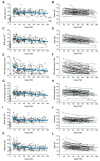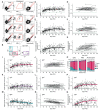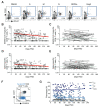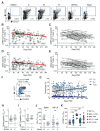Immunological memory to SARS-CoV-2 assessed for up to 8 months after infection
- PMID: 33408181
- PMCID: PMC7919858
- DOI: 10.1126/science.abf4063
Immunological memory to SARS-CoV-2 assessed for up to 8 months after infection
Abstract
Understanding immune memory to severe acute respiratory syndrome coronavirus 2 (SARS-CoV-2) is critical for improving diagnostics and vaccines and for assessing the likely future course of the COVID-19 pandemic. We analyzed multiple compartments of circulating immune memory to SARS-CoV-2 in 254 samples from 188 COVID-19 cases, including 43 samples at ≥6 months after infection. Immunoglobulin G (IgG) to the spike protein was relatively stable over 6+ months. Spike-specific memory B cells were more abundant at 6 months than at 1 month after symptom onset. SARS-CoV-2-specific CD4+ T cells and CD8+ T cells declined with a half-life of 3 to 5 months. By studying antibody, memory B cell, CD4+ T cell, and CD8+ T cell memory to SARS-CoV-2 in an integrated manner, we observed that each component of SARS-CoV-2 immune memory exhibited distinct kinetics.
Copyright © 2021 The Authors, some rights reserved; exclusive licensee American Association for the Advancement of Science. No claim to original U.S. Government Works.
Figures





Update of
-
Immunological memory to SARS-CoV-2 assessed for up to eight months after infection.bioRxiv [Preprint]. 2020 Dec 18:2020.11.15.383323. doi: 10.1101/2020.11.15.383323. bioRxiv. 2020. Update in: Science. 2021 Feb 5;371(6529):eabf4063. doi: 10.1126/science.abf4063. PMID: 33442687 Free PMC article. Updated. Preprint.
Similar articles
-
Safety and immunogenicity of a modified mRNA-lipid nanoparticle vaccine candidate against COVID-19: Results from a phase 1, dose-escalation study.Hum Vaccin Immunother. 2024 Dec 31;20(1):2408863. doi: 10.1080/21645515.2024.2408863. Epub 2024 Oct 18. Hum Vaccin Immunother. 2024. PMID: 39422261 Free PMC article. Clinical Trial.
-
Immunological memory to SARS-CoV-2 assessed for up to eight months after infection.bioRxiv [Preprint]. 2020 Dec 18:2020.11.15.383323. doi: 10.1101/2020.11.15.383323. bioRxiv. 2020. Update in: Science. 2021 Feb 5;371(6529):eabf4063. doi: 10.1126/science.abf4063. PMID: 33442687 Free PMC article. Updated. Preprint.
-
Safety and immunogenicity of an egg-based inactivated Newcastle disease virus vaccine expressing SARS-CoV-2 spike: Interim results of a randomized, placebo-controlled, phase 1/2 trial in Vietnam.Vaccine. 2022 Jun 9;40(26):3621-3632. doi: 10.1016/j.vaccine.2022.04.078. Epub 2022 May 14. Vaccine. 2022. PMID: 35577631 Free PMC article. Clinical Trial.
-
Topical fluoride as a cause of dental fluorosis in children.Cochrane Database Syst Rev. 2024 Jun 20;6(6):CD007693. doi: 10.1002/14651858.CD007693.pub3. Cochrane Database Syst Rev. 2024. PMID: 38899538 Review.
-
Platelet-rich therapies for musculoskeletal soft tissue injuries.Cochrane Database Syst Rev. 2014 Apr 29;2014(4):CD010071. doi: 10.1002/14651858.CD010071.pub3. Cochrane Database Syst Rev. 2014. PMID: 24782334 Free PMC article. Review.
Cited by
-
Identification of virus epitopes and reactive T-cell receptors from memory T cells without peptide synthesis.Commun Biol. 2024 Nov 4;7(1):1432. doi: 10.1038/s42003-024-07048-x. Commun Biol. 2024. PMID: 39496850 Free PMC article.
-
Multiomics Reveals a Mechanism: Glycogen Synthesis, Galactose Metabolism, and Ethanol Degradation Pathways, the Durable Role of Neutralizing Antibodies in Preventing COVID-19.ACS Omega. 2024 Oct 10;9(42):42757-42765. doi: 10.1021/acsomega.4c04047. eCollection 2024 Oct 22. ACS Omega. 2024. PMID: 39464477 Free PMC article.
-
Immune response after COVID-19 vaccination among patients with chronic kidney disease and kidney transplant.Vaccine. 2022 Oct 26;40(45):6499-6511. doi: 10.1016/j.vaccine.2022.09.067. Epub 2022 Sep 28. Vaccine. 2022. PMID: 36202639 Free PMC article.
-
The COVID-19 puzzle: deciphering pathophysiology and phenotypes of a new disease entity.Lancet Respir Med. 2021 Jun;9(6):622-642. doi: 10.1016/S2213-2600(21)00218-6. Epub 2021 May 6. Lancet Respir Med. 2021. PMID: 33965003 Free PMC article. Review.
-
Tissues, not blood, are where immune cells function.Nature. 2021 May;593(7860):506-509. doi: 10.1038/d41586-021-01396-y. Nature. 2021. PMID: 34035530 No abstract available.
References
-
- Grifoni A., Weiskopf D., Ramirez S. I., Mateus J., Dan J. M., Moderbacher C. R., Rawlings S. A., Sutherland A., Premkumar L., Jadi R. S., Marrama D., de Silva A. M., Frazier A., Carlin A. F., Greenbaum J. A., Peters B., Krammer F., Smith D. M., Crotty S., Sette A., Targets of T Cell Responses to SARS-CoV-2 Coronavirus in Humans with COVID-19 Disease and Unexposed Individuals. Cell 181, 1489–1501.e15 (2020). 10.1016/j.cell.2020.05.015 - DOI - PMC - PubMed
-
- Suthar M. S., Zimmerman M. G., Kauffman R. C., Mantus G., Linderman S. L., Hudson W. H., Vanderheiden A., Nyhoff L., Davis C. W., Adekunle O., Affer M., Sherman M., Reynolds S., Verkerke H. P., Alter D. N., Guarner J., Bryksin J., Horwath M. C., Arthur C. M., Saakadze N., Smith G. H., Edupuganti S., Scherer E. M., Hellmeister K., Cheng A., Morales J. A., Neish A. S., Stowell S. R., Frank F., Ortlund E., Anderson E. J., Menachery V. D., Rouphael N., Mehta A. K., Stephens D. S., Ahmed R., Roback J. D., Wrammert J., Rapid generation of neutralizing antibody responses in COVID-19 patients. Cell Rep. Med. 1, 100040 (2020). 10.1016/j.xcrm.2020.100040 - DOI - PMC - PubMed
-
- Rydyznski Moderbacher C., Ramirez S. I., Dan J. M., Grifoni A., Hastie K. M., Weiskopf D., Belanger S., Abbott R. K., Kim C., Choi J., Kato Y., Crotty E. G., Kim C., Rawlings S. A., Mateus J., Tse L. P. V., Frazier A., Baric R., Peters B., Greenbaum J., Ollmann Saphire E., Smith D. M., Sette A., Crotty S., Antigen-specific adaptive immunity to SARS-CoV-2 in acute COVID-19 and associations with age and disease severity. Cell 183, 996–1012.e19 (2020). 10.1016/j.cell.2020.09.038 - DOI - PMC - PubMed
Publication types
MeSH terms
Substances
Grants and funding
LinkOut - more resources
Full Text Sources
Other Literature Sources
Medical
Research Materials
Miscellaneous

